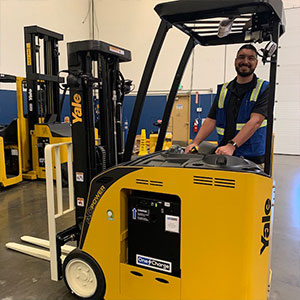
The switch to forklift lithium batteries as the main power source saved hundreds of man-hours in labor, increased uptime, and improved safety, providing an efficiency boost to the distribution center operations.
“Switching from lead-acid batteries to OneCharge lithium let us focus on our patients and not on our batteries! » medical supplies warehouse Supervisor.
Executive Summary
In 2019 one of the US largest Medical Care Distribution Centers in California was struggling with a growing amount of labor related to the daily maintenance of lead-acid forklift batteries. Regular operation disruptions with batteries failing to fully charge in time for the shift decreased uptime and affected productivity.
The switch to the new Li-ion batteries was smooth and did not require any operational infrastructure changes. The results were immediate – zero daily maintenance of batteries, reliable operations, and a 22% reduction of the total cost of ownership of the inventory. The company has made the decision to use Lithium Ion exclusively in all locations going forward.
Challenges
The company has been operating a fleet of 20 electric forklifts for a few years. The ongoing issues with lead-acid batteries started to mount and continually got worse: batteries were getting very hot, inconsistent watering systems meant that the batteries had to be manually watered every week. Occasional acid spills from overwatering damaged the floor coating and the trucks. Routine maintenance of 30-40 minutes quickly turned into 1.5 hours, and then into 2 hours of labor daily! Two workers would come at 5 am each morning before the 1st shift just to take care of the batteries, and still often failed to get them ready in time. Even with all these efforts, the lead-acid batteries were barely lasting three years.
Charging was an issue too, and in some cases, a battery would charge only halfway in 5-6 hours. A driver could come back from lunch to find his truck battery still in need of at least another hour of charge to last him through the rest of the shift.
Not only was productivity adversely affected and overtime pay piled up, but safety was compromised as well. The slippery floor from a mix of water and acid spills and strong odor from the heated batteries became real work environment issues.
How OneCharge Lithium Batteries Helped to Reduce the Total Cost of Ownership
When Jon Rudolph from NITCO introduced the facility management to the new Li-ion technology, the warehouse supervisor was interested, but also apprehensive of the possible technology transfer issues and the costs of a transition to the new Li-ion technology. The team made a field visit to another customer of OneCharge in Chino, CA, which had been using similar trucks and successfully made the transition to lithium batteries earlier.
The management was sold on the idea and supported the move to the new technology. After implementation, the results exceeded expectations: zero daily maintenance of batteries and no more issues with charging. The drivers quickly got into the new ABC charging routine – “always be charging”. With a quick 2-hour charge from zero to full and opportunity charging during lunchtime and breaks, the batteries are always ready for work and easily last through 2 shifts with no power or voltage drop.
The warehouse supervisor was also pleased to find out that the chargers were 4 times smaller for Li-ion batteries and were wall-mounted. This eliminated the risk of riding a truck into a charging stand.
Summary. Results, ROI, and Future Plans
The initial ROI calculations made by Jon Rudolph demonstrated a 22% reduction in the Total Cost of Ownership for their customer’s fleet at their California facility. The savings came from lower electricity costs (30% lower compared to lead-acid) and zero daily maintenance, based on average assumptions. In fact, the savings may be much higher in this situation. The warehouse Supervisor estimated that lead-acid batteries’ maintenance and other batteries related issues added up to 12 man-hours per day. Way above, compared to what was included in Jon’s ROI table.
The supervisor says there are still a few trucks in his warehouse running on lead-acid, and as soon as the contracts expire, he will replace them with Lithium. The company has made the decision to use Lithium Ion exclusively in all locations going forward.
Any major stress on the economy and business propels the trends in technology that were already building momentum, in a “peaceful” time. Efficient Li-ion batteries are replacing the old lead-acid technology. Tried-and-tested lithium solutions are no longer newcomers, and we will see accelerating adoption of Li-ion batteries by all players in material handling over the next few years.
 by Mark D'Amato | mars 23, 2021
by Mark D'Amato | mars 23, 2021